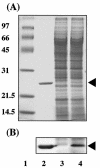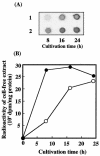Formaldehyde fixation contributes to detoxification for growth of a nonmethylotroph, Burkholderia cepacia TM1, on vanillic acid
- PMID: 14532071
- PMCID: PMC201235
- DOI: 10.1128/AEM.69.10.6128-6132.2003
Formaldehyde fixation contributes to detoxification for growth of a nonmethylotroph, Burkholderia cepacia TM1, on vanillic acid
Abstract
During bacterial degradation of methoxylated lignin monomers, such as vanillin and vanillic acid, formaldehyde is released through the reaction catalyzed by vanillic acid demethylase. When Burkholderia cepacia TM1 was grown on vanillin or vanillic acid as the sole carbon source, the enzymes 3-hexulose-6-phosphate synthase (HPS) and 6-phospho-3-hexuloisomerase (PHI) were induced. These enzymes were also expressed during growth on Luria-Bertani medium containing formaldehyde. To understand the roles of these enzymes, the hps and phi genes from a methylotrophic bacterium, Methylomonas aminofaciens 77a, were introduced into B. cepacia TM1. The transformant strain constitutively expressed the genes for HPS and PHI, and these activities were two- or threefold higher than the activities in the wild strain. Incorporation of [14C]formaldehyde into the cell constituents was increased by overexpression of the genes. Furthermore, the degradation of vanillic acid and the growth yield were significantly improved at a high concentration of vanillic acid (60 mM) in the transformant strain. These results suggest that HPS and PHI play significant roles in the detoxification and assimilation of formaldehyde. This is the first report that enhancement of the HPS/PHI pathway could improve the degradation of vanillic acid in nonmethylotrophic bacteria.
Figures





Similar articles
-
The archaeon Pyrococcus horikoshii possesses a bifunctional enzyme for formaldehyde fixation via the ribulose monophosphate pathway.J Bacteriol. 2005 Jun;187(11):3636-42. doi: 10.1128/JB.187.11.3636-3642.2005. J Bacteriol. 2005. PMID: 15901685 Free PMC article.
-
Genomic organization and biochemistry of the ribulose monophosphate pathway and its application in biotechnology.Appl Microbiol Biotechnol. 2009 Sep;84(3):407-16. doi: 10.1007/s00253-009-2120-7. Epub 2009 Jul 11. Appl Microbiol Biotechnol. 2009. PMID: 19593556 Review.
-
Overexpression of an HPS/PHI fusion enzyme from Mycobacterium gastri in chloroplasts of geranium enhances its ability to assimilate and phytoremediate formaldehyde.Biotechnol Lett. 2010 Oct;32(10):1541-8. doi: 10.1007/s10529-010-0324-7. Epub 2010 Jun 15. Biotechnol Lett. 2010. PMID: 20549541
-
The ribulose monophosphate pathway substitutes for the missing pentose phosphate pathway in the archaeon Thermococcus kodakaraensis.J Bacteriol. 2006 Jul;188(13):4698-704. doi: 10.1128/JB.00492-06. J Bacteriol. 2006. PMID: 16788179 Free PMC article.
-
The physiological role of the ribulose monophosphate pathway in bacteria and archaea.Biosci Biotechnol Biochem. 2006 Jan;70(1):10-21. doi: 10.1271/bbb.70.10. Biosci Biotechnol Biochem. 2006. PMID: 16428816 Review.
Cited by
-
Microbial phenotypic heterogeneity in response to a metabolic toxin: Continuous, dynamically shifting distribution of formaldehyde tolerance in Methylobacterium extorquens populations.PLoS Genet. 2019 Nov 11;15(11):e1008458. doi: 10.1371/journal.pgen.1008458. eCollection 2019 Nov. PLoS Genet. 2019. PMID: 31710603 Free PMC article.
-
Formaldehyde Stress Responses in Bacterial Pathogens.Front Microbiol. 2016 Mar 3;7:257. doi: 10.3389/fmicb.2016.00257. eCollection 2016. Front Microbiol. 2016. PMID: 26973631 Free PMC article. Review.
-
Connecting Algal Polysaccharide Degradation to Formaldehyde Detoxification.Chembiochem. 2022 Jul 19;23(14):e202200269. doi: 10.1002/cbic.202200269. Epub 2022 May 30. Chembiochem. 2022. PMID: 35561127 Free PMC article.
-
Production of polyhydroxyalkanoates by Burkholderia cepacia ATCC 17759 using a detoxified sugar maple hemicellulosic hydrolysate.J Ind Microbiol Biotechnol. 2012 Mar;39(3):459-69. doi: 10.1007/s10295-011-1040-6. Epub 2011 Sep 28. J Ind Microbiol Biotechnol. 2012. PMID: 21953365
-
Cross-Feeding of a Toxic Metabolite in a Synthetic Lignocellulose-Degrading Microbial Community.Microorganisms. 2021 Feb 4;9(2):321. doi: 10.3390/microorganisms9020321. Microorganisms. 2021. PMID: 33557371 Free PMC article.
References
-
- Arfman, N., K. J. de Vries, H. R. Moezelaar, M. M. Attwood, G. K. Robinson, M. van Geel, and L. Dijkhuizen. 1992. Environmental regulation of alcohol metabolism in thermotolerant methylotrophic Bacillus strains. Arch. Microbiol. 157:272-278. - PubMed
-
- Bradford, M. M. 1976. A rapid and sensitive method for the quantitation of microgram quantities of protein utilizing the principle of protein-dye binding. Anal. Biochem. 72:248-254. - PubMed
-
- Codd, G. A., L. Dijkhuzin, and F. R. E. Tabita. 1990. Advances in autotrophic microbiology and one-carbon metabolism, vol. 1, p. 163-191. Kluwer Academic Publishers, Dordrecht, The Netherlands.
-
- Elzer, P. H., M. E. Kovach, R. W. Phillips, G. T. Robertson, K. M. Peterson, and R. M. Roop II. 1995. In vivo and in vitro stability of the broad-host-range cloning vector pBBR1MCS in six Brucella species. Plasmid 33:51-57. - PubMed
-
- Ferdman, M. Y. 1973. Reaction of nucleic acids and nucleoproteins with formaldehyde. Prog. Nucleic Acid Res. Mol. Biol. 13:1-49. - PubMed
Publication types
MeSH terms
Substances
LinkOut - more resources
Full Text Sources
Other Literature Sources

